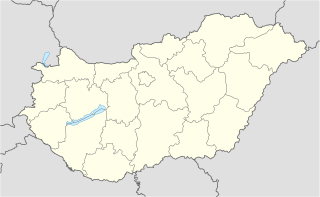
Tolna is an administrative county in present Hungary as it was of the former Kingdom of Hungary. It lies in central Hungary, on the west bank of the river Danube. It shares borders with the Hungarian counties Somogy, Fejér, Bács-Kiskun, and Baranya. The capital of Tolna county is Szekszárd. Its area is 3703 km².

Mali Iđoš is a village and municipality located in the North Bačka District of the autonomous province Vojvodina, Serbia. The municipality comprises three local communities and has a population of 12,031, of whom 6,486 (53.91%) are ethnic Hungarians, 2,388 are Serbs (19.85%) and 1,956 are Montenegrins (16.26%). Mali Iđoš village has a population of 4,830.

Pálháza is a town in Borsod-Abaúj-Zemplén county, Hungary, 87 km (54 mi) east from county capital Miskolc.

Szentistván is a village in Northern Hungary, in the Mezőkövesd district of Borsod-Abaúj-Zemplén county.

Monok is a village in Borsod-Abaúj-Zemplén, Hungary and is part of the Tokaj wine region.

Rákócziújfalu is a village in Jász-Nagykun-Szolnok county, in the Northern Great Plain region of central Hungary.

Ditrău is a commune in Harghita County, Romania. It is composed of three villages:

Karcsa is a village in Borsod-Abaúj-Zemplén county, Hungary, which dates back to the time of the Hungarian settlement. There is a 1000-year-old graveyard in the neighboring town Karos and archaeological discoveries confirm this. The village is well known for its Romanesque church built probably around 1000 after the Huns converted to Christianity. Karcsa was situated in what was north-central Hungary from the founding of the country until 1920 when the Treaty of Trianon split Hungary, depriving it of 70% of its territory and leaving 60% of its people in surrounding countries. Now it is a border town on the northern Hungarian border with Slovakia. Karcsa has a small lake which is quite popular with fishermen and campers in summer and for skating in winter. Karcsa, although it doesn't have any claim to fame other than its church, is near many popular sightseeing areas: Nagy Rozvagy which has an annual summer "ancient village" festival, showing how the Huns lived, and Karos, the 1000-year-old Hun cemetery, and the Tokaj wine region.

Teresztenye is a village in Borsod-Abaúj-Zemplén county, in the north-east region of Hungary.

Uppony is a village in Borsod-Abaúj-Zemplén county, Hungary.

Vatta is a village in Borsod-Abaúj-Zemplén County, Hungary. It lies in the south of the county, 30 km (20 mi) from Miskolc and 19 km (12 mi) from Mezőkövesd.

Csenyéte is a village in Borsod-Abaúj-Zemplén county, Hungary.

Tornaszentandrás is a village in Borsod-Abaúj-Zemplén County, in Hungary. The name literally means 'Saint Andrew in Torna County'.

Türje is a village in Zala County, Hungary. The village is located in the North-Eastern part of Zala County, near the great turn of Zala river, between the Keszthelyi Mountains and Kemeneshát Hills. The village has a railway station on the line of the Boba–Őrihodos railway which is connecting the two local centers of Zalaegerszeg and Celldömölk. It is also connected with Zalaszentgrót by bus.

Mánfa is a village in Baranya county, Hungary.

Dunaszekcső is a village in Baranya County, Hungary, situated on the right bank of the River Danube. The inhabitants are ethnic Hungarian, with minorities of Serbs and Danube Swabians. The population was about 1900 in 2015.

Kórós is a village in Hungary, Baranya county, in the Ormánság region. The village lies near the river Drava. The Calvinist church of Kórós is famous for its painted ceiling, which is considered a masterpiece of Hungarian folk art.

Tornanádaska is a village in the Edelényi kistérség, Borsod-Abaúj-Zemplén County.

Hangács is a village in Borsod-Abaúj-Zemplén County in northeastern Hungary. As of 2008 it had a population of 645. In 2009 it had a population of 653. Hangács is a heavily gypsy-infested village. In January 2010, two Hungarian villagers were attacked by a gang of gypsies. Two gypsies were killed in the ensuing clash.

Regéc is a village in Borsod-Abaúj-Zemplén County in northeastern Hungary.













